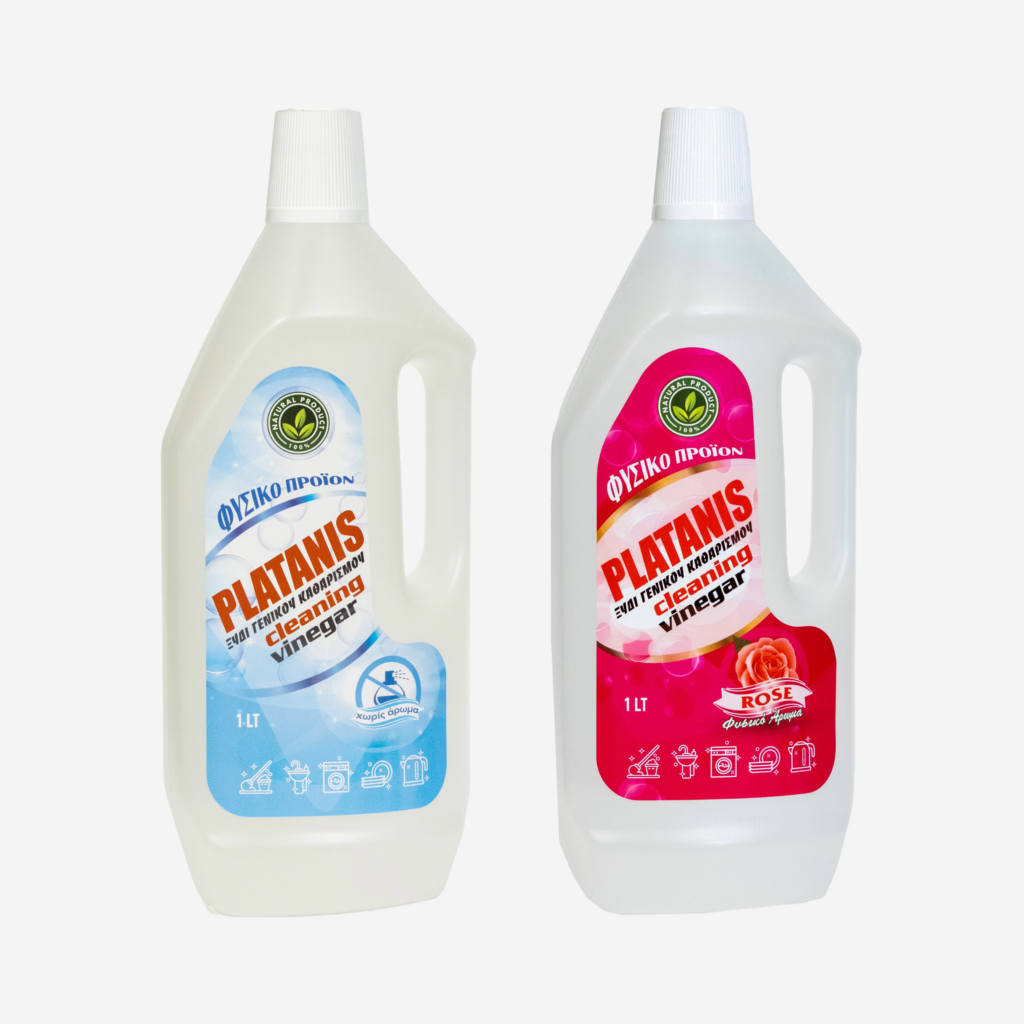Cleaning Vinegar

Platanis Cleaning Vinegar
Cleaning vinegar at 8% concentration is a type of vinegar that contains 8% acetic acid, making it stronger and more effective for cleaning purposes than regular white vinegar, which typically contains around 4.5%-6% acetic acid. The higher acidity gives cleaning vinegar enhanced cleaning power, allowing it to tackle tougher stains, grease, mineral deposits, and grime. Despite its increased strength, it’s still a natural cleaner, free of harsh chemicals.
CAUTION!
Cleaning vinegar should not be consumed as it can cause serious health risks, including gastrointestinal irritation and internal chemical burns.
Due to its stronger acidity, it should be used with caution on delicate surfaces, as it can potentially cause damage if not properly diluted.
Technical Details
Properties
- Acetic Acid Content (8%): Cleaning vinegar has a higher concentration of acetic acid (8%) compared to regular vinegar (4.5%-6%). This increased acidity enhances its ability to break down organic compounds, making it more effective for cleaning and disinfecting.
- pH Level (2.4-3.4): Due to its acetic acid content, cleaning vinegar has a low pH, typically around 2.4 to 3.4. This acidic nature makes it effective at dissolving minerals, grease, and grime but also means it can be corrosive to certain materials like marble or metal if not properly diluted.
Hazards and Precautions
- Skin and Eye Irritation: The higher acidity of cleaning vinegar can cause irritation if it comes into contact with the skin or eyes. Direct exposure can lead to redness, burning sensations, or more serious irritation, especially in sensitive areas.
- Corrosive to Certain Surfaces: Cleaning vinegar can be corrosive to surfaces like natural stone (e.g., marble, granite), certain metals (e.g., aluminum, copper), and rubber. Prolonged exposure can lead to damage or discoloration of these materials.
- Respiratory Irritation: Inhaling the fumes of concentrated cleaning vinegar can irritate the respiratory system, especially in enclosed spaces. This can cause coughing, throat irritation, or discomfort, particularly for individuals with respiratory conditions like asthma.
- Use Protective Gear: When handling cleaning vinegar, especially for extended periods or on large surfaces, wear gloves to protect your skin. It’s also advisable to wear safety glasses or goggles to prevent accidental splashes into your eyes.
- Ventilation: Ensure good ventilation when using cleaning vinegar, especially in enclosed spaces. Open windows or use fans to disperse the fumes and minimize the risk of respiratory irritation.
- Dilution and Spot Testing: Before applying cleaning vinegar to a large area, especially on delicate surfaces, dilute it with water (typically a 1:1 ratio) and perform a spot test on a small, inconspicuous area. This helps ensure that the vinegar won’t cause damage or discoloration.
Size
Our Cleaning Vinegar is available in 1L size bottles, in an unscented and a rose scented option.
Usage Ideas
- Coffee Maker Cleaning:
Descale your coffee maker by filling the container with a 1:2 mixture of Cleaning Vinegar and water. Run the machine with an empty coffee filter, discard the liquid and filter, and repeat the process with clean water. Rinse the jug thoroughly.CAUTION! Check the coffee maker’s manual for specific cleaning instructions.
- Kettle Descaling:
Remove limescale by filling the kettle with a mixture of one cup Cleaning Vinegar and two cups of water. Boil the mixture, let it sit for 3–5 minutes, and then rinse thoroughly with clean water. Repeat with clean water as needed. - Laundry Enhancer:
Fabric Softener: Add 30 ml of Cleaning Vinegar to the final rinse water to soften clothes and remove detergent residues.Sweat Stain Removal: Spray vinegar on armpit stains before washing to eliminate marks.
Washing Machine Maintenance: Pour 1 cup of Cleaning Vinegar into the drum and run a normal cycle without laundry to remove detergent residue and lint.
- Dishwasher Maintenance:
Remove food and soap residue by pouring 1 cup of Cleaning Vinegar into the bottom of the dishwasher and running a cycle without dishes.CAUTION! Check your dishwasher’s manual, as vinegar may damage some rubber components.
- Windows and Mirrors:
Clean windows and mirrors by applying unscented Cleaning Vinegar with a soft cloth for a streak-free shine. - Floor Cleaning:
Mix 1 glass of Cleaning Vinegar with 5 liters of water to mop and disinfect floors. - Carpet Cleaning:
For annual cleaning, mix warm water and Cleaning Vinegar in a 4:1 ratio.
Use a small brush to clean carpets, brushing in the direction of the pile.
Dry carpets in a shady area to preserve colors.CAUTION! Use unscented Cleaning Vinegar.
- Kitchen Cleaning:
Clean appliances (oven, microwave, refrigerator) with a 1:5 Cleaning Vinegar and water solution. Spray and wipe with a clean cloth.
Deodorize trash bins by spraying the inside with Cleaning Vinegar and wiping with a sponge. - Bathroom Cleaning:
Remove salt stains from tubs and sinks by wiping with a cloth dampened in Cleaning Vinegar.
Soak clogged faucets and showerheads in diluted Cleaning Vinegar, scrub, and rinse thoroughly. - Unclogging Drains:
Combine Cleaning Vinegar with 1 tbsp of baking soda to unclog sinks or basins. Let it sit for 30 minutes and rinse with boiling water. Beware that the reaction with baking soda will cause foaming.CAUTION! The uses listed above are based on consumer feedback and empirical solutions, not officially tested or approved by the manufacturer. Always test on an inconspicuous area first, and adjust mixture proportions as needed.
Embrace the multi-tasking power of Platanis Cleaning Vinegar.
Feeling Inspired?

